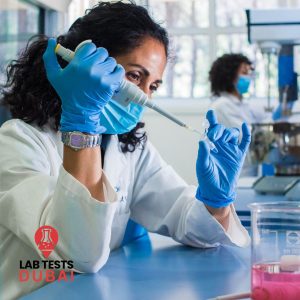
Electron Microscopy Tissue Test High-Resolution Analysis – Accurate Diagnostic Testing
3.450,00 د.إ
Electron Microscopy Tissue Test is a specialized test designed for the ultrastructural examination of tissue samples, including kidney, muscle, and tumor tissues.
Methodology : Electron Microscopy
TAT : 15 Days
Description
Electron Microscopy Tissue Test – High-Resolution Analysis for Accurate Diagnostic Testing
The Electron Microscopy (EM) Tissue Test from Lab Tests Dubai is a cutting-edge diagnostic servicethat provides ultra-high-resolution imaging of tissue samples at the subcellular and molecular level—far beyond the capabilities of conventional light microscopy.
Using transmission electron microscopy (TEM), this advanced test enables pathologists to examine cellular organelles, basement membranes, protein deposits, and pathological inclusions with nanometer-level precision. It is indispensable for diagnosing complex conditions such as:
- Glomerular diseases (e.g., Alport syndrome, FSGS, membranous nephropathy)
- Mitochondrial myopathies and metabolic muscle disorders
- Unclassified tumors and rare cancers
- Storage diseases and lysosomal disorders
Available in partnership with tertiary care hospitals and specialized pathology centers, this test supports nephrologists, neurologists, oncologists, and researchers in delivering definitive diagnoseswhen standard tests fall short.
With a 15-day turnaround time, Lab Tests Dubai brings world-class ultrastructural pathology to the UAE—ensuring timely, accurate, and life-changing diagnoses.
Why You Need This Test
When light microscopy and immunohistochemistry are not enough, electron microscopy is the next frontier in diagnostic precision.
You need this test if:
- A kidney biopsy shows proteinuria or hematuria with inconclusive light microscopy results
- You’re being evaluated for inherited or metabolic muscle disease (e.g., mitochondrial disorders)
- A tumor is histologically ambiguous and needs ultrastructural classification
- You have suspected Alport syndrome, Fabry disease, or amyloidosis
- You’re part of a research study requiring subcellular analysis
EM detects:
- Split basement membranes (Alport syndrome)
- Abnormal mitochondria (mitochondrial myopathy)
- Immune complex deposits (lupus nephritis)
- Crystalline inclusions (e.g., light chain deposition disease)
This test doesn’t just confirm—it reveals the invisible.
Symptoms That Indicate This Test
Consider Electron Microscopy if you or a patient has:
✅ For Kidney Disease:
- Persistent proteinuria (foamy urine) or hematuria (blood in urine)
- Unexplained nephrotic or nephritic syndrome
- Family history of hereditary kidney disease
✅ For Muscle Disorders:
- Progressive muscle weakness or fatigue
- Exercise intolerance or muscle pain
- Elevated CK levels without clear cause
✅ For Tumors & Rare Diseases:
- Poorly differentiated tumor on biopsy
- Suspected neuroendocrine, mesothelial, or sarcomatous origin
- Signs of lysosomal storage disease (organomegaly, developmental delay)
These conditions often require ultrastructural confirmation—only possible with electron microscopy.
Natural Production: How Cellular Structures Reveal Disease
Healthy tissues maintain complex subcellular architecture:
- Kidney podocytes with interdigitating foot processes
- Muscle mitochondria packed with cristae for energy
- Basement membranes with uniform thickness
But in disease:
- Genetic mutations disrupt collagen in basement membranes (e.g., Alport)
- Mitochondrial DNA defects cause swollen, abnormal mitochondria
- Immune complexes deposit in glomeruli (e.g., lupus)
- Amyloid fibrils appear as non-branching, rigid filaments
Electron microscopy visualizes these ultrastructural changes—providing definitive evidence of disease that immunostains or light microscopy may miss.
This test is not about function—it’s about structure—and structure tells the truth.
What Happens If Untreated? Risks of Delayed or Missed Diagnosis
Ignoring the need for ultrastructural analysis can lead to: ⚠️ Misdiagnosis or diagnostic delay—leading to wrong treatments
⚠️ Progression of kidney disease to end-stage renal failure
⚠️ Irreversible muscle damage in mitochondrial disorders
⚠️ Ineffective cancer therapy due to incorrect tumor classification
⚠️ Genetic transmission of hereditary diseases to offspring
Early EM analysis ensures:
- Correct diagnosis
- Targeted treatment
- Genetic counseling
- Family screening
In rare diseases, one EM image can change everything.
How to Prepare for the Test
This test does not require patient preparation—but here’s what you should know:
✅ The tissue sample must be collected via biopsy:
- Kidney (percutaneous or surgical)
- Muscle (quadriceps or biceps)
- Tumor or lesion (surgical excision or core biopsy)
✅ Special handling required:
- Tissue must be placed in glutaraldehyde fixative immediately after collection
- Transported cold (4°C) to the lab within 1–2 hours
- Not suitable for formalin-fixed paraffin-embedded (FFPE) blocks
✅ Inform your doctor if you’re on:
- Anticoagulants (risk of bleeding during biopsy)
- Immunosuppressants (may affect tissue appearance)
Lab Tests Dubai coordinates with hospitals and pathology units to ensure proper fixation, transport, and processing.
Test Overview: Gold-Standard Electron Microscopy Method
| Feature | Details |
| Test Name | Electron Microscopy – Tissue (Ultrastructural Analysis) |
| Sample Type | Fresh Tissue: Kidney, Muscle, Tumor, or Other Biopsy |
| Methodology | Transmission Electron Microscopy (TEM) |
| Turnaround Time (TAT) | 15 Days |
| Category | Advanced Pathology / Diagnostic Cytology |
| Purpose | Diagnose glomerular, mitochondrial, and rare diseases |
| Testing Location | Partnered Reference Labs – Accredited & CLIA-Compliant |
Transmission Electron Microscopy (TEM) uses a beam of electrons to image tissue at up to 500,000x magnification, revealing:
- Foot process effacement in podocytes
- Mitochondrial cristae abnormalities
- Immune complex deposits
- Fibrils, crystals, or inclusion bodies
Results include:
- High-resolution EM images
- Detailed pathology report
- Clinical correlation notes
FAQs About the Electron Microscopy Tissue Test
Q: Can this test be done on a routine biopsy?
A: Only if fixed in glutaraldehyde. Formalin-fixed tissue is not suitable for EM.
Q: Is this test available for children?
A: Yes. Critical for diagnosing hereditary kidney and muscle diseases in pediatric patients.
Q: Can EM differentiate between tumor types?
A: Yes. It identifies neurosecretory granules, cilia, desmosomes, helping classify carcinomas, sarcomas, and lymphomas.
Q: How will I get results?
A: A secure digital report is emailed within 15 business days, including EM images and expert pathology interpretation.
Q: Is this test covered by insurance?
A: Most UAE insurers cover EM for diagnostic biopsies—check with your provider.
Q: Can I book without a doctor’s referral?
A: No. This is a specialized pathology test—requires biopsy and physician coordination.
When standard tests can’t give you answers, electron microscopy can.





Reviews
There are no reviews yet.